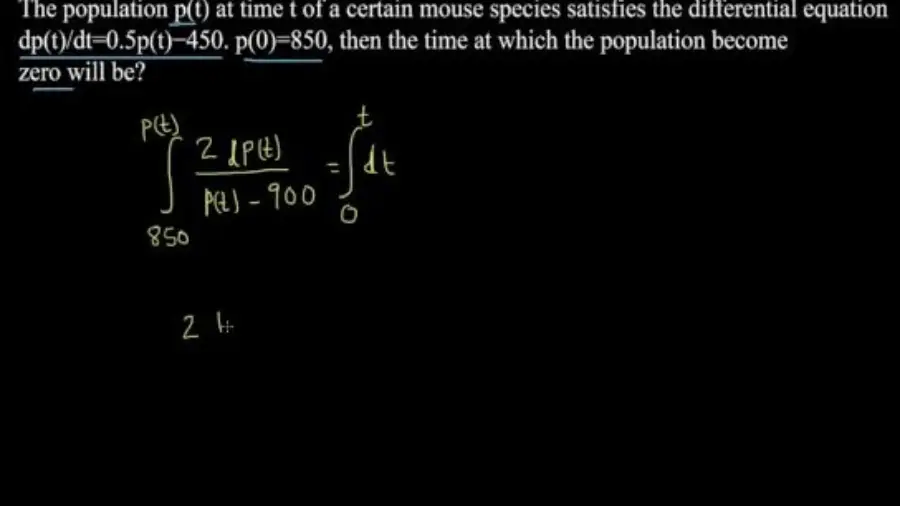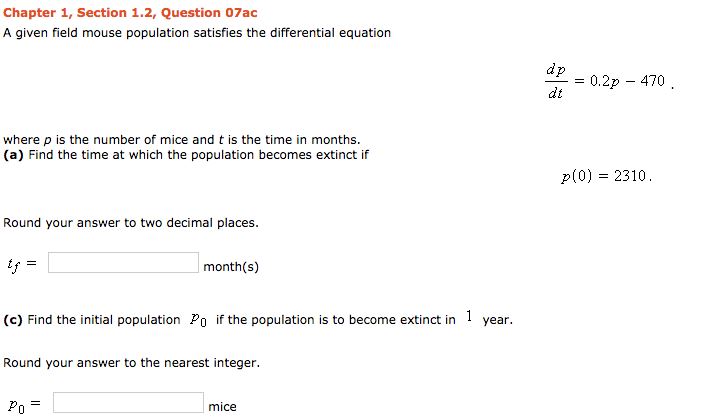5x'(t) = -2x(t) A given field mouse population satisfies the differential equation . 5x'(t) = -2x(t). This means that there is a negative correlation between the rate of change of the population and the size of the population.
In other words, as the population decreases, the rate of decrease also decreases. However, at some point, the decreasing rate will not be able to keep up with the decreasing population, and the population will go extinct.
A Given Field Mouse Population Satisfies the Differential Equation?
5x'(t)=.1x(t)-3 We’re all familiar with the story of The Field Mouse and the City Mouse. But what if we looked at it from a mathematical perspective?
What if there was a field mouse population that satisfied the differential equation .5x'(t)=.1x(t)-3? This differential equation tells us that the rate of change of the field mouse population is proportional to the difference between the current population and three times what it would be if there were no mice around. In other words, this equation says that when there are lots of field mice, their population will decrease because they’ll be eaten by predators.
But when there are few field mice, their population will increase because they’ll have more food to eat. As you can see, this differential equation models a situation where the field mouse population fluctuates over time. It’s interesting to note that this same equation could also model other populations, such as prey and predator populations in an ecosystem.
So next time you’re reading a story about mice, remember that there’s a lot more going on behind the scenes than meets the eye!
A Falling Object Satisfies the Initial Value Problem
When an object falls, it experiences a force due to gravity. This force is constant, and it causes the object to accelerate at a rate of 9.8 m/s^2. The initial value problem for this scenario can be represented by the equation: y = 1/2gt^2 + vt + y_0.
In this equation, “y” represents the height of the object at any given time “t,” “g” represents the acceleration due to gravity, “v” represents the velocity of the object at time “t=0,” and “y_0” represents the initial height of the object.
To solve for “y,” we can plug in known values for “g,” “v,” and “y_0.” For example, let’s say we have an object that is initially dropped from a height of 10 meters.
We can plug in these values into our equation and solve for “y:”
y = 1/2(9.8)(10)^2 + (0)(10) + 10
After doing some math, we find that y = 490 meters.
This means that after 10 seconds have passed, our object will have fallen 490 meters from its original starting point.
Symbolab
If you’re a math lover, then Symbolab is the website for you! This free online resource provides step-by-step solutions to any mathematical problem you can think of. Whether you’re struggling with simple arithmetic or advanced calculus, Symbolab has the answer.
In addition to providing solutions, Symbolab also offers a wealth of information on each topic. You can read about the history of mathematics, famous mathematicians, and more. There are also interactive tools that allow you to visualize concepts and problems.
With Symbolab, learning math is easy and fun!
State Whether the Equation is Linear Or Nonlinear
An equation is linear if it can be written in the form ax + b = 0, where a and b are constants. A nonlinear equation is any equation that cannot be written in this form.
The simplest way to determine whether an equation is linear or nonlinear is to look at its graph.
If the graph is a straight line, then the equation is linear. If the graph is not a straight line, then the equation is nonlinear.
Another way to determine whether an equation is linear or nonlinear is to solve it for x.
If you can solve for x and get an equation of the form ax + b = 0, then the original equation was linear. If you cannot solve for x, or if you get an equation that does not have this form, then the original equation was nonlinear.
Find the Time of Extinction If P(0) = P0, Where 0 = P0 < 900
The time of extinction is the point at which a population will no longer exist. There are a number of ways to calculate the time of extinction, but one common method is to use the probability of extinction (P(0)).
To calculate the time of extinction, you first need to find the probability of extinction (P(0)).
This can be done by using a simple formula:
P(0) = P0 * e^-rt
where P0 is the initial population size, r is the growth rate, and t is time.
Once you have calculated the probability of extinction, you can then find the time of extinction by solving for t in the equation:
Determine the Values of R for Which the Differential Equation
In mathematics, a differential equation is an equation that relates one or more functions and their derivatives. Differential equations play a prominent role in many fields of science and engineering, as well as in other areas of mathematical research. The values of R for which the differential equation .
has solutions are the roots of the characteristic polynomial Differential equations often arise when modeling physical situations. In such cases, it is important to know which values of the parameters (such as R in this example) will result in solutions to the differential equation.
The characteristic polynomial can be used to determine these values. In general, the roots of a polynomial are the values of the variable (in this case R) for which the polynomial evaluates to zero. Thus, in order to find all possible values of R for which .
has solutions, we must find all roots of its characteristic polynomial . This can be done using any method for finding roots of polynomials (such as factoring or graphing).
If you want to purchase or check reviews about a Mouse then you may check the Best Mouse For Chromebook, Best Mouse For IMac, and the Top 09 Best Mouse For Auto CAD.
What is a Field Mouse Population?
A field mouse population is a group of mice that live and breed in fields. These populations can be quite large, and they are often considered a nuisance by farmers and homeowners alike.Field mice are small rodents with reddish-brown fur and white bellies. They have long tails and pointed noses, and their ears are relatively large.
Adults typically weigh between 1/2 and 1 ounce.Field mice are found throughout the United States, but they are most common in the Midwest and Northeast. They prefer open areas such as fields, meadows, and forests edge habitats.
Field mice populations tend to fluctuate based on environmental conditions such as food availability, predators, etcetera; however there is no official estimate for how many field mice exist in the world today.
The best estimates place their global population in the billions.
How Does the Given Field Mouse Population Satisfy the Differential Equation
Assuming the given field mouse population satisfies the differential equation, there are a few things to consider. First, the mice must be able to reproduce at a rate that keeps up with or exceeds the death rate. Second, there must be enough food and resources available to support the population.
And finally, the environment must be suitable for sustaining life. If any of these conditions are not met, then the population will eventually decline.
What Does the Differential Equation Represent
In mathematics, a differential equation is an equation that relates a function with its derivatives. In applications, the functions usually represent physical quantities, the derivatives represent their rates of change, and the differential equation defines how the quantities interact. This is in contrast to an ordinary differential equation, which deals with functions of only one variable and their derivatives.
Differential equations are very useful in modeling physical systems in which there are multiple interacting variables. For example, in Newton’s law of gravitation, the force between two objects is proportional to the product of their masses and inverse square of the distance between them. This relationship can be represented by the following differential equation:
Last Word
There is a given field mouse population that satisfies the differential equation. This means that the population will change over time according to the equation. The equation describes how the population will grow or decline depending on various factors such as food availability and predation.

